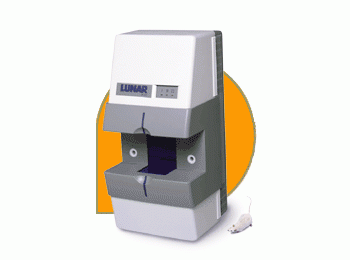
The PIXImus (General Electric) uses the principles of dual x-ray absorptiometry (DXA) to measure bone mineral density, lean and fat tissue masses for small animals that weigh less than approximately 75 g. Two X-ray beams, with different energy levels, are aimed at the mouse. When soft tissue absorption is subtracted out, the bone mineral density (BMD) can be determined from the absorption of each beam by bone. The PIXImus measurement requires that the animal is immobilized during the measurement. Mice must be sedated before and throughout the measurement.
Regulatory Approvals and Setup
- Add the procedure to your animal protocol and get this approved by the BCM IACUC. Please note that if you plan to do this on live mice, you also must have the use of anesthesia approved on your protocol.
- Before using the instrument, each user must be approved on the MMRU X-ray protocol. Contact the Radiation Safety office for necessary on-line training that must be completed first. Once you have done this, let them know, and ask to be added to Dr. Fiorotto’ X-ray license (AX124). Please copy Dr. Fiorotto on the request.
- Once approved on both your animal and the X-ray protocols, contact Dr. Fiorotto for a hands-on learning session.
- The instrument is used in CNRF procedure room 1074. The lab should be booked ahead of time by contacting Dr. Fiorotto.
Measurement Procedure
- Set up the instrument in room 1074. This should include the anesthesia machine if you plan to use isoflurane with a live animal.
- Request measurement trays from MMRU staff. Lightly anesthetize a mouse by placing it in a chamber with isoflurane (5% and 95% oxygen). As soon as the mouse is sedated it is oriented carefully on a disposable PIXImus measuring tray for proper alignment and is fitted with a loosely fitting nose cone for administration of isoflurane (2% isoflurane) until the measurement is complete. If you prefer, you may use an injectable anesthetic.
- The mouse is inserted into the instrument for measurement (approx. 5 minutes) and then returned to a cage to recover under observation. Once fully recovered the mouse can be returned to its home cage.
- Fill out the logbook when you have finished a session. Note that there is a limit in the number of measurements that can be done in a session. This will be explained during training.
There are some systematic errors in the lean and fat mass values obtained by PIXImus that vary depending on the instrument model and software version (see References). To provide more accurate measurements, we have derived some correction equations to apply to the data generated by the CNRC PIXImus. The procedure and further information can be found below.
Download calculator for adjusting PIXImus body composition data to chemical analysis-comparable values (Microsoft Excel spreadsheet)
PIXImus Request and Use Procedures
- You will need to get IACUC approval for performing the procedure on your animals, including the use of anesthesia.
- Once this is approved, you will need to be trained by MMRU staff on how to use the instrument, and when this is accomplished, you will need to be added as a user to Dr. Fiorotto’s X-ray protocol.
- If you use isoflurane, you must provide the necessary setup and the anesthesia.
- To book the instrument, e-mail Dr. Fiorotto stating your approved animal protocol number, charge source, when you wish to use it, and for how long.
- After you have finished using the instrument sign the logbook entering all the requested information.
- Clean the PIXImus when you are done, and make sure to take your data with you.
- Inform MMRU staff that you have completed your study.








